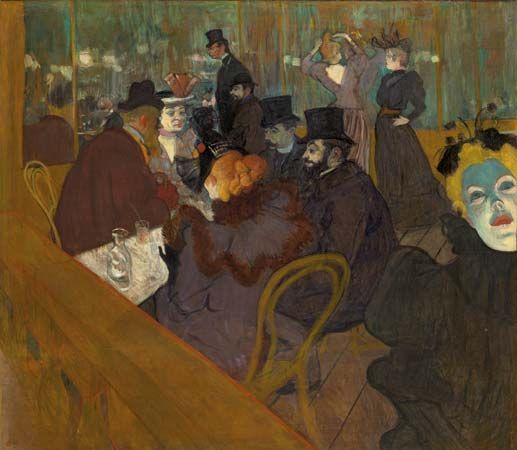cabaret
Our editors will review what you’ve submitted and determine whether to revise the article.
- Related Topics:
- theatrical production
- Grand Guignol
- taproom concert
- On the Web:
- Masterworks Broadway - Cabaret – Original Broadway Cast Recording 1966 (Oct. 25, 2024)
cabaret, restaurant that serves liquor and offers a variety of musical entertainment.
The cabaret probably originated in France in the 1880s as a small club in which the audience was grouped around a platform. The entertainment at first consisted of a series of amateur acts linked together by a master of ceremonies; its coarse humour was usually directed against the conventions of bourgeois society. The typical program, which first flourished in the Montmartre district of Paris at the tiny Chat Noir in 1881, listed poetry readings, shadow plays, songs, and comic skits. The primary exponent of French cabaret entertainment was the Moulin Rouge, in Paris; established in 1889 as a dance hall, it featured a cabaret show in which the cancan was first performed and in which many major stars of variety and music hall later appeared. The world of the Moulin Rouge in its heyday was immortalized in the graphic art of Henri de Toulouse-Lautrec.
Imported from France about 1900, the first German Kabarett was established in Berlin by Baron Ernst von Wolzogen. It retained the intimate atmosphere, entertainment platform, and improvisational character of the French cabaret but developed its own characteristic gallows humour. By the late 1920s the German cabaret gradually had come to feature mildly risqué musical entertainment for the middle-class man, as well as biting political and social satire. It was also a centre for underground political and literary movements. Patronized by artists, writers, political revolutionaries, and intellectuals, the German cabarets were usually located in old cellars. They were the centres of leftist opposition to the rise of the German Nazi Party and often experienced Nazi retaliation for their criticism of the government. The composers Paul Hindemith and Erik Satie, unknown at the time, were active in the cabarets; so also were the playwrights Bertolt Brecht and Frank Wedekind. The musical show Cabaret (1966) and a film version (1972) portrayed the 1930s German cabaret, as inspired by Anglo-American writer Christopher Isherwood’s Berlin Stories. The cabaret survived in post-World War II Germany as a forum for topical satire, but it lost most of its political significance.
Comparable cabarets thrived in Barcelona, Kraków, Moscow, and St. Petersburg during the 20th century. Tristan Tzara’s Cabaret Voltaire in Zürich (1916–17) was the breeding ground of Dada, a platform for radical experimentation in poetry, fine art, and music. The English cabaret had its roots in the taproom concerts given in city taverns during the 18th and 19th centuries. A popular form by the end of the 19th century, it was often called a music hall, although music hall usually meant variety entertainment in England.
In the United States, where it was usually called a nightclub, the cabaret during the second half of the 20th century was one of the few remaining places where an entertainer, usually a comedian, singer, or musician, could establish rapport with an audience in an intimate atmosphere that encouraged improvisation and freedom of material. Although music for dancing was often provided during the entertainers’ intermissions, the primary attraction was the featured entertainer. In the post-World War II period a few performers were successful with sharp political and social satire, but commercial considerations were paramount, and nightclubs relied chiefly on established theatrical personalities who could attract a wide audience. By 1980 many nightclubs had disappeared, giving way to theatre restaurants and entertainment centres with larger seating capacity. This style of entertainment is carried on in comedy clubs, preeminent among which is Chicago’s Second City, and in a musical “torch song” lounge tradition that revives jazz and musical theatre repertoires in programs performed by solo vocalists. The material at comedy clubs may be political, while the performances at singing clubs generally eschew such controversy.











